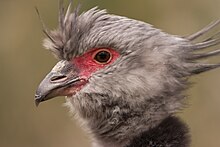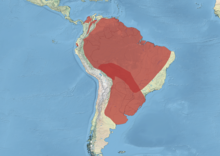Anhimidae
| Screamer | |
|---|---|
 |
|
| Southern screamer (Chauna torquata) | |
| Scientific classification | |
| Kingdom: | Animalia |
| Phylum: | Chordata |
| Class: | Aves |
| Order: | Anseriformes |
| Clade: | Anseres |
| Family: |
Anhimidae Stejneger, 1885 |
| Genera | |
 |
|
| The world distribution/species density of screamers | |
The screamers are a small clade of birds (Anhimidae). For a long time, they were thought to be most closely related to the Galliformes because of similar bills, but they are instead more closely related to ducks (family Anatidae), most closely to the magpie goose (which some DNA evidence suggests are closer to screamers than to ducks). The clade is exceptional within the living birds in lacking uncinate processes of ribs. The screamers are represented by three species, the horned screamer (Anhima cornuta), the southern screamer or crested screamer (Chauna torquata) and the northern screamer or black-necked screamer (Chauna chavaria). A penis is absent in the males, and the birds' skin has a layer about a quarter of an inch thick that is filled with small bubbles of air, which produce a crackling sound when pressed.
Anhimids have a notoriously poor fossil record. A putative Eocene specimen is known from Wyoming, while the more modern Chaunoides antiquus is known from the late Oligocene to early Miocene in Brazil. Anhimids are most similar to presbyornithids, with which they form a clade to the exclusion of the rest of Anseriformes. Given the presence of lamelae in the otherwise fowl-like beaks of screamers, it is even possible that they evolved from presbyornithid-grade birds, reverting from a filter-feeding lifestyle to an herbivorous one.
The three species occur only in South America, ranging from Colombia to northern Argentina. They are large, bulky birds, with a small downy head, long legs and large feet which are only partially webbed. They have large spurs on their wings which are used in fights over mates and territorial disputes; these can break off in the breast of other screamers, and are regularly renewed. Unlike ducks they have a partial moult, and are able to fly throughout the year. They live in open areas and marshes with some grass and feed on water plants. One species, the southern screamer, is considered a pest as it raids crops and competes with farm birds.
...
Wikipedia
